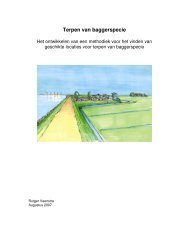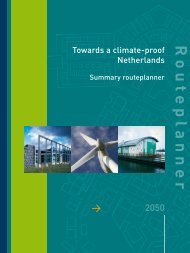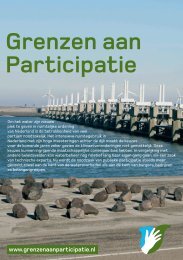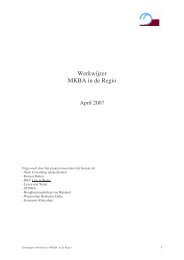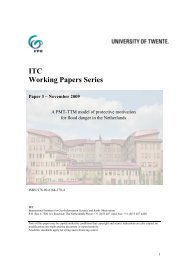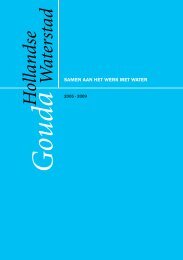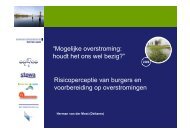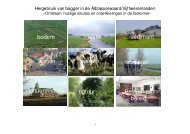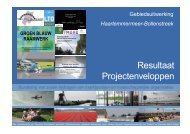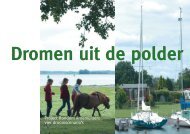KvR report 001/2006maybe coupled partly to GDP and populati<strong>on</strong> density, but <strong>the</strong> causal links do notappear straightforward.Available indicators in WDDGoing back to <strong>the</strong> ideas presented in <strong>the</strong> introductory chapters, many <strong>of</strong> <strong>the</strong>problems and measures facing <strong>deltas</strong> are related to water and sediment. A firstinventory <strong>of</strong> WDD variables is presented in Table 5.2. Vuln/pot indicates that <strong>the</strong>variable could possibly be an indicator under ei<strong>the</strong>r <strong>the</strong> vulnerability group, or <strong>the</strong>potential for s<strong>of</strong>t measures group. WDD does not c<strong>on</strong>tain socio-ec<strong>on</strong>omic data.Secti<strong>on</strong> 5.2 gives a descripti<strong>on</strong> <strong>of</strong> Database A and B. Coleman et al. (2004) provide amore detailed descripti<strong>on</strong> <strong>of</strong> <strong>the</strong> variables <strong>of</strong> Database A.Table 5.2:abbreviati<strong>on</strong>Annual Ave discharge(m 3 /s)50Spreadsheet <strong>with</strong> potential WDD indicators. Given are <strong>the</strong> abbreviati<strong>on</strong><strong>of</strong> <strong>the</strong> indicator as used in <strong>the</strong> database, its potential as indicator forvulnerability or potential for s<strong>of</strong>t measures, respectively, <strong>the</strong> source <strong>of</strong><strong>the</strong> data (i.e. which database) and a brief descripti<strong>on</strong>.vuln/pot*Max Discharge v aMin Discharge v aSed Discharge v + p bdb descripti<strong>on</strong>a/b**v a discharge <strong>of</strong> water, data for river discharge came from varioussources notably Vorosmarty, Fekete and Tucker (1998)Delta Area v + p a delta area in sq km, interpreted from maps and satellite imagesSubaerial/Subaqueous v + p a ratio <strong>of</strong> subaerial/subaqueous delta area, calculated from <strong>the</strong>area <strong>of</strong> <strong>the</strong> delta plain as measured <strong>on</strong> maps and images anddata derived from bathymetric maps for <strong>the</strong> area <strong>of</strong> <strong>the</strong>subaqueous deltaShoreline v a ratio <strong>of</strong> actual shoreline length to <strong>the</strong> width <strong>of</strong> <strong>the</strong> delta plain, anindicati<strong>on</strong> <strong>of</strong> <strong>the</strong> smoothness <strong>of</strong> <strong>the</strong> delta shoreline. Those<strong>deltas</strong> <strong>with</strong> very large ratios are usually <strong>the</strong> <strong>deltas</strong> in whichriverine processes are dominant, while those <strong>with</strong> very lowratios are <strong>deltas</strong> in which wave energy and currents smooth <strong>the</strong>delta shoreline# River Mouths v a number <strong>of</strong> active river mouths from examinati<strong>on</strong> <strong>of</strong> maps andsatellite imagesOffshore Slope v + p a average <strong>of</strong>fshore slope fr<strong>on</strong>ting <strong>the</strong> delta, derived by measuring<strong>of</strong>fshore pr<strong>of</strong>iles at selected intervals al<strong>on</strong>g <strong>the</strong> delta fr<strong>on</strong>t <strong>on</strong>hydrographic mapsSpring Tide v a tidal range, from published articlesWave Power Shoreline a wave power computed at <strong>the</strong> 10 meter c<strong>on</strong>tour in 107ergs/sec/m coastline, from a computer programRMS Wave Height v a root mean square wave height derived from marine atlases.Input for significant wave height (Hs) and maximum waveheight (Hmax)* Potential as indicator for physical vulnerability (v), or potential for system-based approaches (p)** Source: database a/b<str<strong>on</strong>g>Deltas</str<strong>on</strong>g> <strong>on</strong> <strong>the</strong> <strong>move</strong>Available indicators in DIVAThe DIVA tool reports some indicators <strong>on</strong> a per-segment basis, o<strong>the</strong>rs peradministrative unit and again o<strong>the</strong>rs <strong>on</strong> a per-country basis. We list a number <strong>of</strong>DIVA-indicators tabulated according to spatial scale (segment, admin unit or country,Table 5.3) and ranked as ei<strong>the</strong>r signifying ‘physical vulnerability’, ‘societal stock atrisk’ or ‘potential for s<strong>of</strong>t measures’. Clearly, <strong>the</strong> number <strong>of</strong> potentially relevantindicators is substantial. Socio-ec<strong>on</strong>omic stocks at risk can be read from GDP percountry or per administrative unit, people at risk, total land loss, <strong>the</strong> flooded z<strong>on</strong>e,people in <strong>the</strong> hazard z<strong>on</strong>e, or from a compound indicator combining <strong>the</strong>se. Most <strong>of</strong><strong>the</strong>se are reported at <strong>the</strong> administrative unit (province) level. Geomorphological,physical vulnerability indicators are more <strong>of</strong>ten available at <strong>the</strong> coastline segmentlevel.DIVA output is aggregated to <strong>the</strong> administrative unit before it is made available at <strong>the</strong>users interface in DIVA. Still, a few output variables have been selected that arespecific for rivers. DIVA calculates <strong>the</strong> distance upriver where <strong>the</strong> influence <strong>of</strong> <strong>the</strong>sea is still measurable (i.e. as tidal fluctuati<strong>on</strong>s), but also <strong>the</strong> distance <strong>of</strong> salt intrusi<strong>on</strong>upriver.Table 5.3:scaleSpreadsheet <strong>with</strong> selected DIVA indicators. Given are a qualificati<strong>on</strong> <strong>of</strong><strong>the</strong> spatial scale <strong>of</strong> <strong>the</strong> indicator applied by <strong>the</strong> DIVA tool, itsabbreviati<strong>on</strong> used in <strong>the</strong> database, its potential as indicator for physicalvulnerability, stock at risk or potential for s<strong>of</strong>t measures, respectively,<strong>the</strong> type <strong>of</strong> DIVA variable, and a brief descripti<strong>on</strong>.abbreviati<strong>on</strong> v/s/p PDIVOV descripti<strong>on</strong>country sdikecost s + p p country-specific costs <strong>of</strong> rising a standard dike <strong>of</strong> 1 kmlength <strong>with</strong> 1 m in US$ <strong>of</strong> 1995gdpc s iv per capita GDP in 1995 US$adminunittourarr s iv number <strong>of</strong> internati<strong>on</strong>al tourist arrivals in a country in 1995gdpmulti s p GDP per capita multiplier to adjust GDP for an admin unitfrom <strong>the</strong> average <strong>of</strong> a countryPotlandlosserosi<strong>on</strong>v + s ovPotential land loss due to direct and indirect erosi<strong>on</strong>,ignoring beach nourishment, km 2 /ypaf s ov People at risk <strong>of</strong> flooding: average number <strong>of</strong> peopleflooded per year by storm surge allowing for <strong>the</strong> effect <strong>of</strong>flood defenses (administrative level). Aggregati<strong>on</strong> rule, sum<strong>of</strong> coastline segments <strong>with</strong>in administrative unit.potfloodplain v + s ov Land area below <strong>the</strong> <strong>on</strong>e in <strong>on</strong>e thousand flood level,ignoring see dikes (km 2 )peoplepotentiallyflooded, ppfs People in flood hazard z<strong>on</strong>e: people living below 1000 yearsurge (admin level). Aggregati<strong>on</strong> rule, sum <strong>of</strong> coastlinesegments <strong>with</strong>in administrative unit (1000s <strong>of</strong> people)rslr v ov Mean change in relative sea level compared to <strong>the</strong>reference year (1995) weighted by segment length (adminlevel). It c<strong>on</strong>siders (1) human-induced clim. change underselected scenario, (2) uplift/subsidence due to glacial-isost.adjustment and (3) natural subsidence <strong>of</strong> deltaic areas (m)Sumn wetl p ov sum <strong>of</strong> area <strong>of</strong> all coastal wetland types in admin unit (km 2 )51
KvR report 001/2006scaleabbreviati<strong>on</strong> v/s/p PDIVOV descripti<strong>on</strong>coastline areaunderxsegment (x=1,2, ..,13_16)v p area in <strong>the</strong> coastal z<strong>on</strong>e <strong>with</strong> elevati<strong>on</strong> below 1m aboveAMSL or in <strong>the</strong> elevati<strong>on</strong> class 1-2 m, 2-3 m etc given,derived from GTOPO30 digital elevati<strong>on</strong> datasetcsvs v ov coastal segment vulnerability score, a compound variable,use <strong>with</strong> cauti<strong>on</strong>latitude p latitude <strong>of</strong> midpoint <strong>of</strong> segmentl<strong>on</strong>gitude p l<strong>on</strong>gitude <strong>of</strong> midpoint <strong>of</strong> segmentsurgeh1yr, v p 1in 1 1in 10 etc surge height including high water level,10, 100, 1000above mean sea level, maxsurge = surgeh1000 + 3 (m)sedsup v + p p compound variable, scaled to 5 cat: 1=low vulnerability sohigh sed availability, 5 = high vulnerability so low sedimentsupply; includes tect<strong>on</strong>ics, river discharge and distance totthat river, sea ice and distance tot that ice, inlet or opencoast, presence <strong>of</strong> dikes, history <strong>of</strong> exploitati<strong>on</strong> <strong>of</strong> <strong>the</strong> coast;all weighed and <strong>the</strong>n <strong>the</strong> total scaled between 1 and 5slope p? p slope <strong>of</strong> land up to 3 m above max surge level.mediantide v p tidal range, based <strong>on</strong> LOICZ classes: 1 no tide, 2 < 2 meter,3: 2-4 m, 4: 5-8 m 5: >8m; here median values <strong>of</strong> each classare takenupsub v p uplift/subsidence (mm/yr), uplift is positive.wavclim v p wave <strong>climate</strong> based <strong>on</strong> LOICZ classes: 0 no wavespermanant sea ice; 1 0-2.5 m, 2: 2.5-3.5 m, 3 3.5-5 m, 4 5-6.5 m, 5 > 6.5 maspace v + p iv accommodati<strong>on</strong> space, potential for wetland migrati<strong>on</strong> intoland, depending <strong>on</strong> landforms and presence <strong>of</strong> dikes, scaledbetween 1 and 5, <strong>with</strong> 5 = vulnerable, loss is probable solittle room for accommodati<strong>on</strong>copopd s iv populati<strong>on</strong> density <strong>on</strong> <strong>the</strong> coast, that is in a z<strong>on</strong>e <strong>of</strong> 2.5 kmbehind <strong>the</strong> coastal segment (N/km2)sdikehght v iv sea dike height, calculated height <strong>of</strong> a dike <strong>on</strong> a segmentriver rivimpact v ov distance to where <strong>the</strong> influence <strong>of</strong> <strong>the</strong> sea is still measurablesegment(km)salintru v ov distance <strong>of</strong> salt intrusi<strong>on</strong> into <strong>the</strong> river (km)<str<strong>on</strong>g>Deltas</str<strong>on</strong>g> <strong>on</strong> <strong>the</strong> <strong>move</strong>5.6 Indicator testing and selecti<strong>on</strong>Which potential indicators should now become <strong>the</strong> DELTAS indicators to beincorporated in <strong>the</strong> computer-based system? The potential indicators becomeDELTAS indicators <strong>on</strong>ce <strong>the</strong>y have passed our tests. The testing comprised <strong>of</strong>:looking at <strong>the</strong> quality and validity <strong>of</strong> <strong>the</strong> data by plotting potential variables andexamining <strong>the</strong>ir variability. Variability was assessed first in bivariate correlati<strong>on</strong>s, andsec<strong>on</strong>d by an objective data reducti<strong>on</strong> approach, here a simple Principal Comp<strong>on</strong>entAnalysis (PCA; J<strong>on</strong>gman et al., 1987). Note that <strong>the</strong> correlati<strong>on</strong> results do notnecessarily imply causal links: correlated phenomena can have a separate, comm<strong>on</strong>cause. The PCA was introduced because <strong>the</strong> values for <strong>the</strong> potential indicatorsshould differentiate over <strong>deltas</strong> to enable ranking <strong>of</strong> <strong>the</strong>se <strong>deltas</strong>, and becausecovariance am<strong>on</strong>g <strong>the</strong> many different potential indicators necessitated selecti<strong>on</strong> <strong>of</strong> afew major indicators that toge<strong>the</strong>r would explain most <strong>of</strong> <strong>the</strong> total observed variati<strong>on</strong>.After all, our aim is to show which <strong>deltas</strong> are most suitable for (certain groups <strong>of</strong>)system-based measures. These steps lead to an objective selecti<strong>on</strong> <strong>of</strong> a few majorindicators, and are placed in a separate, well elaborated Annex 1.In this Annex 1 we first show some <strong>of</strong> our best results <strong>of</strong> testing <strong>with</strong>in <strong>the</strong> individualWDD and DIVA databases. We <strong>the</strong>n merge <strong>the</strong> two data sets and come to ac<strong>on</strong>solidated list <strong>of</strong> indicators, which is presented below. This list is subsequentlyentered as a spreadsheet table for querying through <strong>the</strong> website user interface (seeChapter 6).Selected indicatorsBased <strong>on</strong> an efficient representati<strong>on</strong> <strong>of</strong> <strong>the</strong> total variability present in <strong>the</strong> database,and our detailed assessment <strong>of</strong> all potentially useful indicators in WDD and DIVA(Annex 1), we propose to select three priority indicators: surge height <strong>with</strong> a 1/100 yprobability, ‘coastal lowland area available 0-2 m above mean sea level’ and ‘peoplepotentially flooded in 2000’. The latter is <strong>the</strong> main indicator for stocks at risk, and <strong>the</strong>former two serve as indicators for vulnerability, which will be higher <strong>with</strong> higher surgeheights and in smaller coastal plains. The potential for s<strong>of</strong>t system-based measureswould <strong>the</strong>n be best judged from <strong>the</strong> area <strong>of</strong> coastal plain. We propose a range <strong>of</strong>specific indicators from our combined WDD and DIVA database and have arranged<strong>the</strong>m in Table 5.4 below, where we also give a brief justificati<strong>on</strong> for each.notes:scale spatial scale <strong>of</strong> DIVA input/outputv/s/p whe<strong>the</strong>r <strong>the</strong> indicator would feature for physical vulnerability (v), societal stocks atrisk (s), or potential for s<strong>of</strong>t measures (p)PDIVOV type <strong>of</strong> DIVA-defined variable: parameter (fixed), driver (fixed), initial or input variableoutput variable.For <strong>the</strong> following output variables (ov) <strong>the</strong> values have been estimated <strong>with</strong> DIVA for A2 and B1scenarios and <strong>the</strong> year 2100: potlandlosserosi<strong>on</strong>, paf, potfloodplain, rslr, sumnaturalwetlands5253



